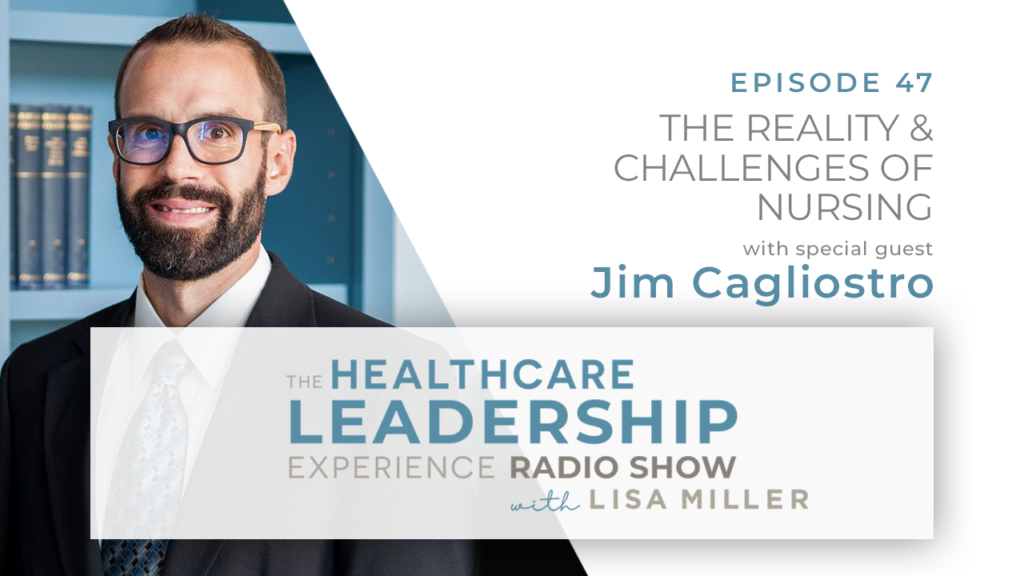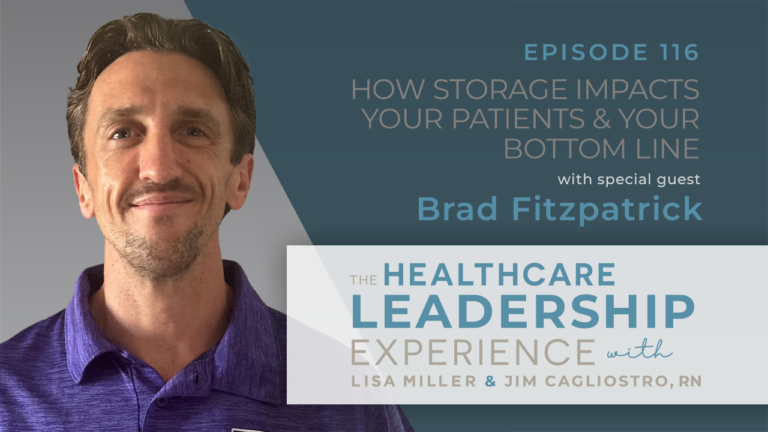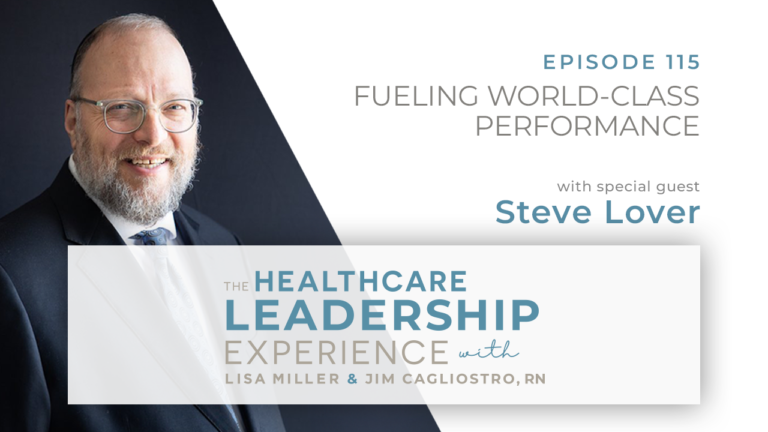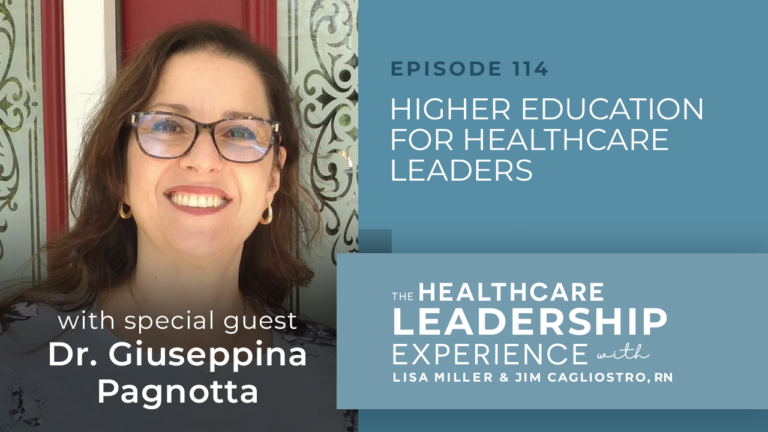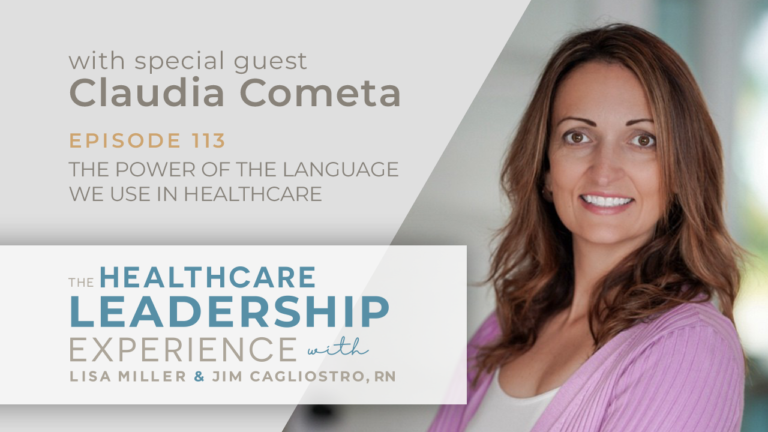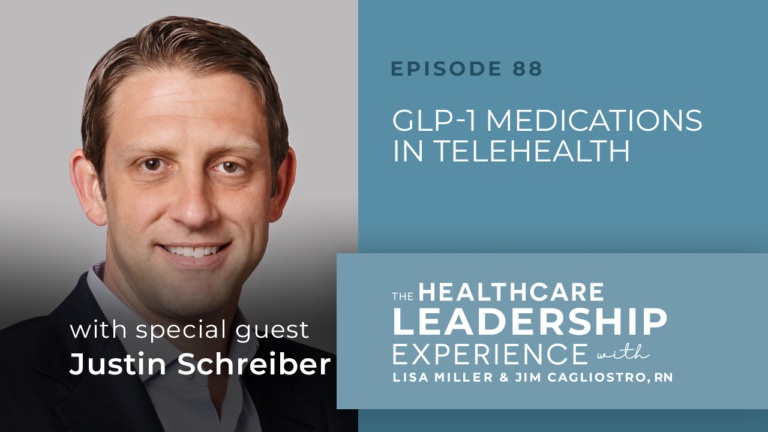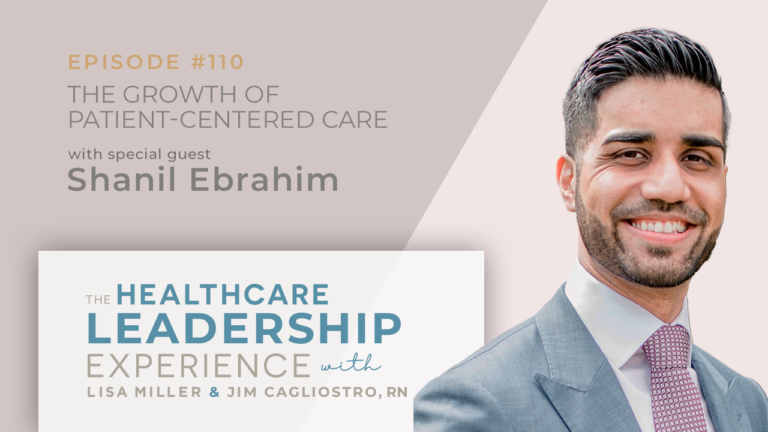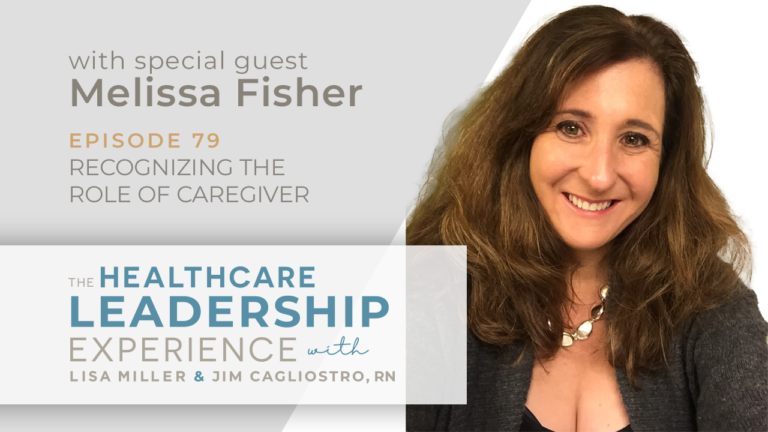In Episode 47 of The Healthcare Leadership Experience, Lisa is joined by Jim Cagliostro, a Registered Nurse and VIE’s Clinical Operations Performance Improvement Expert. Together they discuss the evolving role of nursing in today’s healthcare organizations and its inherent challenges.
Episode Introduction
The role of nursing has undergone a transformation in recent years, accelerated by COVID. Physician shortages have had a key impact on this evolution, but burnout is still the reality for many nurses. In this first episode of a two-part discussion, VIE Healthcare Consulting’s founder and CEO Lisa Miller interviewed Jim Cagliostro to discuss the day-to-day demands on the nursing profession, offer strategies to prevent burnout, and discuss the role of nurses in leadership.
Show Topics
- The evolving role of nursing in the US
- CRNAs operate without an on-site anesthesiologist
- Specialized nursing roles lead to better and safer patient care
- Learning the business side of healthcare
- The current state of the nursing profession
- Understanding the causes of burnout
- Nursing in leadership: having a seat at the table
01:55 The evolving role of nursing in the US
Jim explained that nursing has expanded beyond the traditional helping role.
‘’… nurses as the frontline healthcare providers, they have grown also to become the backbone of the healthcare system because it’s no longer viewed as just a helping role. Nursing has become a more prominent profession that has had a louder voice. Maybe the voice hasn’t gotten louder, but maybe it’s that more people are listening. I mean, there’s so many descriptions we can give for nurses: patient advocates, policy makers, researchers, educators, community partners, caregivers. There are so many different descriptions in terms of what nurses do. So I love being a nurse. And I think when I got into it, I didn’t realize just the breadth of what that might include, what it means to be a nurse. But I’m excited to be a part of a profession that really does have an impact in so many different aspects of healthcare in this country.’’
04:02: CRNAs operate without an on-site anesthesiologist
Jim said that due to staffing shortages, the need for nursing practitioners and CRNAs is increasing.
‘’I remember there was a client we were working with, and we were looking just at the topic of CRNAs, certified registered nurse anesthetists. And I know not in New Jersey, but in some other states, CRNAs are legally allowed to operate without an anesthesiologist on site. And simply that’s just out of need. You have very rural locations, and you simply don’t have enough anesthesiologists to cover every surgery center or whatever the operation might be in a very rural location. And so you have those who are still nurses. Now they’ve had more training, they’ve had more experience and they’re perfectly capable of handling whatever the situation might be, but nurse practitioners is another example. They might work under the authority of a physician, but the need for nurse practitioners has really increased. And that’s even before COVID.’’
06:47 Specialized nursing roles lead to better and safer patient care
Jim said that the passion at the heart of nursing can help hospitals to establish effective policies, in addition to better and safer patient care.
‘’I mentioned specialized roles like the nurse anesthetists and nurse practitioners. Those again are increasing in terms of not just the numbers, but what they’re able to do and how they’re able to provide better patient care. And that’s in partnership with the whole system and partnership with physicians and administrators. I think the value comes in when there’s like the hands-on direct patient care that nurses have as their foundation. That’s where our training is. That’s where our heart is. I believe that lays a wonderful foundation to bring with us into other areas, whether it’s leadership, management, helping in terms of policy and creating policy that works because a lot of times I think in our minds… But policies are made by those who… whatever their educational background is, but then when it comes down to the rubber hitting the road, it doesn’t necessarily work that way. And so when you have someone with a nursing background and someone with that experience at the bedside, that can really aid in terms of establishing policies that work, that you know are going to work on a day to day. And it’s not going to create barriers to care, but it’s going to make it possible to provide excellent care and safe care.’’
10:41 Learning the business side of healthcare
Lisa emphasized the benefits that learning the business side of healthcare brings to nursing.
‘’ I thought about it from a resident perspective and nursing, and there’s a class on the business side of healthcare. I think it would be valuable because I feel like it’s like anything else in life. If you’re not exposed to it then, okay, well, you’re not exposed to a nursing school. Or for me, I wasn’t exposed to a clinical side and had to learn in our experience. So I tremendously value when we come into a hospital, we’re working with nurses and clinicians and they explain to us the specifics behind what we’re looking at. I’m like, “Oh, well, that makes sense. Okay, well, now I understand why you would use that product versus something else or why that might be more expensive.” And so I can really appreciate that frontline experience where we really push to understand that.’’
14:27 The current state of the nursing profession
Jim said after the last two years of COVID, nursing staff are facing burnout.
‘’Well, one thing, whenever somebody asks me that question I say, “The current state of nursing is tired.” And that’s not just how I feel, but you talk with people and you read where people are doing studies on nurses and at various stages in their career, nurses are tired, especially after the last two years, especially in the hospital, but everywhere. They’ve been through a lot, we’ve been through a lot in terms of a profession. COVID has also, it’s brought attention to the nursing profession. So it’s a good thing. There’s definitely been… I think respect for the profession has grown over the last two years in terms of what nurses do on a daily basis. And you see some of the sacrifices, some of these long shifts that nurses are taking without a break, without even a break to go to the bathroom. Now, things have settled down, I believe, and things are getting better because the last two years have really opened our eyes. And I think burnout and early retirement is a reality’’.
18:46 Understanding the causes of burnout
Jim discussed the potential causes of burnout and why increasing pay isn’t a long-term solution.
‘’Sometimes if we get into this job where we’re going in and we’re not being challenged, but it’s still taxing us, it’s still physically draining on us, but we’re mentally not being challenged or stretched, that can lead to burnout. That’s not something that would come to mind normally. But the fact that you mentioned it, and I know I shared with you working for VIE, that was a new challenge for me. It was stretching me, but it definitely got me more engaged in the work. And so I think having opportunities for nurses to get engaged in their work or to look for innovation, that can definitely prevent burnout. But I think initially when people talk about burnout, they’ll say, “Well, how can we prevent that? Well, here, let’s just pay the nurses better, let’s just pay the frontline workers better.” And I just say, great, sure we’re all in favor of more pay for those who are providing direct care, but I think that only pushes off the inevitable.’’
20:04 Strategies to prevent burnout
Jim offered several strategies to help prevent nursing burnout, from better nurse to patient ratios to guaranteed breaks.
‘’I’ll go through probably a list in my mind here that come to mind in terms of preventing burnout. And please Lisa, feel free to stop me at any of them. But I think policy changes where again, you have nurses in leadership that are helping to create policies, better conditions in the hospital in particular, better nurse to patient ratios, more support staff. So even if you don’t have better nurse to patient ratios, maybe you have an extra patient care assistant or maybe you have two or three extra that can just help answer call bells and help with cleaning and trips to the bathroom just to kind of ease the stress on the nursing staff. Better staffing, where you’re not constantly running shorthanded if one nurse calls off, but you have provisions for that. Ensuring breaks on longer shifts. I know that’s something historically that’s been discussed.’’
21:09 Nursing in leadership: having a seat at the table
Jim recommended that nurses be empowered in leadership roles to improve staff retention.
‘’And then lastly, I know we’ve touched on this. I’d say having nurses in leadership. I think you hear the phrase, “Having a seat at the table.” But not just having a seat at the table, but really listening to nurses and allowing nurses to be in positions of leadership to say, “Hey, this is how we can make a difference. This is how we can create a better condition where we’re not losing our nurses.”
You’ll Also Hear:
- Why the nursing profession is critical to the survival and success of healthcare in the United States.
- Bridging the gap in a skills shortage: How staffing shortages and an aging population have transformed traditional nursing. ‘’In the last five to ten years, advanced practice nurses have really been able to fill in the gaps that have arisen, just because of the need of an aging population.’’
- The growth of formal education in nursing, from Florence Nightingale, to present day.
- Training future leaders for healthcare: why a diploma in the patient experience can transform patient care.
- Why expanding the nursing skillset can open up the potential for more cost savings. ‘’Whether it’s analytics or cost or reimbursement or even negotiation….I think it’s important even to have some exposure and pointers or skills you can have in your mind … to be confident maybe to push a little bit more…or ask different questions.‘’
- The impact of COVID and two types of reaction: while some nurses are leaving, others have discovered their vocation.
- The other side of patient satisfaction – expressing gratitude for the nursing profession ‘’..from a patient perspective and their families, we need to just really be so grateful for nurses and need to be reminded that they are really sacrificing their life in a lot of cases, especially in COVID.’’
- Why nursing needs leadership that listens. ‘’The cost of training a new nurse is so much more expensive, of finding nurses, bringing them in, orienting them, training them, rather than just keeping the great nurses that you already have. ‘’
What To Do Next:
- Subscribe to The Cost Advantage for Healthcare Leaders and receive a special report on 15 Effective Cost Savings Strategies.
- Learn more about the simple 3 step process to work with us.
- If you are interested in learning more, the quickest way to get your questions answered is to speak with one of our margin improvement experts. Schedule a call with our team.
Show Links
Connect with Jim Cagliostro on LinkedIn
Connect with Lisa on LinkedIn
Check out VIE Healthcare Consulting
Episode Transcripts
CLICK HERE TO DOWNLOAD THE PDF TRANSCRIPT
CLICK HERE TO OPEN THE TRANSCRIPT
Introduction (00:02):
Welcome to the Healthcare Leadership Experience Radio Show with your host, Lisa Miller. Lisa is an entrepreneur, inventor, advisor and founder of VIE Healthcare Consulting, the leading healthcare advisory and analytics firm, helping hospitals accelerate their margin improvement goals.
Lisa loves to think differently and collaborates with leaders and their teams to solve challenges and to create new innovative approaches that impact the clinical and business side of healthcare. Our show will bring you leaders and innovators within healthcare and across multiple industries.
Be a part of the discussion that will give you a unique perspective, deep insights and roadmaps to successfully help you navigate the clinical, financial, and operations of healthcare. Your show starts now.
Lisa (00:49):
Welcome to The Healthcare Leadership Experience Radio Show on HealthcareNOW Radio. I’m Lisa Miller, your host. And today, I welcome to the show Jim Cagliostro from VIE Healthcare. Jim is a registered nurse, and today we begin with the first conversation of our two-part series on nursing. This is going to be a great conversation. Welcome, Jim, to the show.
Jim (01:13):
Thank you. It’s great to be back. Thank you.
Lisa Miller (01:14):
Jim is also clinical operations performance improvement here at VIE, and he’s also very active on LinkedIn and social media, and we love seeing him and reading all the posts you put up about nursing. I always enjoy seeing everything you put out on LinkedIn and really an advocate for nursing, as you should be. I think our discussion today is really a follow-through with your advocacy and your promotion of nursing on social media. So, we will jump in.
Jim Cagliostro(01:44):
Awesome.
Lisa Miller (01:46):
First question, why is the nursing profession so essential to the survival and future of healthcare in this country?
Jim Cagliostro(01:55):
I enjoy talking about this topic because it is something… I think it’s important for me to stop and think about it. The latest numbers that I have, at least the highest number I saw is that there’s 4.2 million nurses in this country right now, registered nurses in this country. Depending on the resource you look at, you might get a different number, but that’s a lot of nurses in terms of just keeping our healthcare system operating in a way that works. And obviously it’s been stretched over the last two years, but nurses as providers of direct care, they’re the frontline workers. That’s a common phrase that we’ve used to describe nurses, especially over the last two years. But nurses as the frontline healthcare providers, they have grown also to become the backbone of the healthcare system because it’s no longer viewed as just a helping role.
Jim Cagliostro(02:46):
Nursing has become a more prominent profession that has had a louder voice. Maybe the voice hasn’t gotten louder, but maybe it’s that more people are listening. I mean, there’s so many descriptions we can give for nurses: patient advocates, policy makers, researchers, educators, community partners, caregivers. There’s so many different descriptions in terms of what nurses do. So I love being a nurse. And I think when I got into it, I didn’t realize just the breadth of what that might include, what it means to be a nurse. But I’m excited to be a part of a profession that really does have an impact in so many different aspects of healthcare in this country.
Lisa Miller (03:25):
I want to stay on this topic for a minute. I want to throw you a curve ball maybe because you said something that’s so true. That nurses are now becoming probably even more vital to being a provider of direct care than ever before. So it seems to me that some of the issues with maybe staffing with nurses, but there’s also a secondary issue maybe with even some shortages with physicians. So it would seem to me that nursing even becomes even more elevated as we have some challenges on the physician side, right? I mean, is that what you’re hearing or talking about with your colleagues?
Jim Cagliostro(04:02):
Absolutely. It’s something that I know, even with VIE, I remember there was a client we were working with and we were looking just at the topic of CRNAs, Certified Registered Nurse Anesthetists. And I know not in New Jersey, but in some other states, CRNAs are legally allowed to operate without an anesthesiologist on site. And simply that’s just out of need. You have very rural locations and you simply don’t have enough anesthesiologists to cover every surgery center or whatever the operation might be in a very rural location. And so you have those who are still nurses. Now they’ve had more training, they’ve had more experience and they’re perfectly capable of handling whatever the situation might be, but nurse practitioners is another example. They might work under the authority of a physician, but the need for nurse practitioners has really increased. And that’s even before COVID. Maybe within the last 5 to 10 years they’ve seen where nurses in various roles, advanced practice nurses have really been able to fill in the gaps that have arisen, just because of the need of an aging population, a population where… Well, we have a healthcare system that really can address illness, health needs. And so people are living longer. But with that being said, people also need care for many more years to come. So nurses have…
Lisa Miller (05:21):
Yeah, more intensive care. But you bring up a really good point, Jim, in that the CNAs really have filled a gap or a need for anesthesiologist. And you wonder what are the lessons we can learn? And where else, other than like you mentioned, nurse practitioners, are there other places within a hospital where something similar like that can happen? I mean, we certainly need some innovation to fill the gaps because we do have an aging population and they need more care. And I think that’s going to be a pretty unique challenge for us as well. So how has nursing in the US changed over the years? I know we know COVID years, but even before that, just some history or just over the last several years, have you seen nursing change?
Jim Cagliostro(06:07):
Sure. I think I might have mentioned this, where it’s no longer viewed as strictly a helper’s role or an assistant role. Again, there’s nothing specifically wrong with that in terms of sure you need help. You need assistance in terms of physicians and surgeons in the OR and at the bedside. But nursing has definitely… Well, formal education. We could talk about that first. I think I might have my years wrong, but Florence Nightingale, it was sometime in the 1860s where the first formal nursing school was established. And then in the US, I believe it was like 1870s, 1880s, where formal nursing schools were being established to say, “Hey, this is a role that is extremely important.”
Jim Cagliostro(06:47):
So formal education has grown. There’s definitely more leadership opportunities for nurses, more leadership roles. And then you think now that’s historically over a last long while, but even over the last two years, you look at how telemedicine and mobile health has increased. And there’s been a number of occasions over the last few years where I’ve spoken with a registered nurse just for that initial triage or assessment to say, “Okay, what’s the appropriate intervention?” Whether it’s COVID testing or going to the emergency room, a lot of health systems now are saying, “Well, we want you to speak to a nurse first before you show up at our doors, just so that we can triage better, so we can provide more efficient care.” I mentioned specialized roles like the nurse anesthetists and nurse practitioners. Those again are increasing in terms of not just the numbers, but what they’re able to do and how they’re able to provide better patient care. And that’s in partnership with the whole system and partnership with physicians and administrators.
Jim Cagliostro(07:45):
I think the value comes in when there’s like the hands-on direct patient care that nurses have as their foundation. That’s where our training is. That’s where our heart is. I believe that lays a wonderful foundation to bring with us into other areas — whether it’s leadership, management, helping in terms of policy and creating policy that works because a lot of times I think in our minds… But policies are made by those who… whatever their educational background is, but then when it comes down to the rubber hitting the road, it doesn’t necessarily work that way.
Jim Cagliostro(08:19):
And so when you have someone with a nursing background and someone with that experience at the bedside, that can really aid in terms of establishing policies that work, that you know are going to work on a day to day. And it’s not going to create barriers to care, but it’s going to make it possible to provide excellent care and safe care.
Lisa Miller (08:35):
I like that because sometimes things in the classroom or things in theory are very different than the real world, right? And so you take a nurse leader in a practical environment and create policies or interventions, or even connect the clinical to the business side of healthcare. Over the years, I’ve met some amazing nurses who have been able to really walk that tight rope of being patient advocate and quality of healthcare as primary, yet also understand as a business side, the healthcare. I’ve also seen a lot of nurse leaders really embracing the business side more. You and I have talked about this a little bit. So I have a quick question, which I’ve never asked you. Do you take any business classes when you’re in nursing school?
Jim Cagliostro(09:22):
No, that’s a great question. In terms of undergraduate, getting my bachelor’s, no business… It’s touched on, but there’s not a formal class that’s strictly the business side. And I think I’ve mentioned to you, working with VIE, I’ve learned so much in terms of the business side. And as a bedside nurse, working with patients, you know that side exists, but you don’t ever venture into it. You kind of steer clear and you let the business experts deal with that. But it’s something I’ve really appreciated working with VIE.
Jim Cagliostro(09:51):
I know I’ve had conversations with some of my managers in the past, and I think I shared with you. Prior to VIE, all of my bosses have been nurses. They’ve had a history and experience as registered nurses, but also, I should make a point to say they have gone on to further their education. So we need to be careful to say, “Hey, that bedside experience is important, but there also needs to be a recognition, ‘Hey, if I’m going to serve as a manager of a unit, or maybe the director of perioperative services in a hospital, I need to listen to the people who know the business side of it.'” And like I said, I’ve learned a lot from you, and just recognizing the business side of healthcare. It is a business too. And so we need to acknowledge there’s some knowledge that I need to gain and experience that we need to gain if we want to operate efficiently and really make this work. It’s not just that bedside experience. That’s a great point, Lisa.
Lisa Miller (10:41):
Yeah. I thought about it from a resident perspective and nursing, and there’s a class on the business side of healthcare. I think it would be valuable because I feel like it’s like anything else in life. If you’re not exposed to it then, okay, well, you’re not exposed to a nursing school. Or for me, I wasn’t exposed to a clinical side and had to learn in our experience. So I tremendously value when we come into a hospital, we’re working with nurses and clinicians and they explain to us the specifics behind what we’re looking at. I’m like, “Oh, well, that makes sense. Okay, well, now I understand why you would use that product versus something else or why that might be more expensive.” And so I can really appreciate that frontline experience where we really push to understand that.
Jim Cagliostro(11:30):
Sure.
Lisa Miller (11:31):
I think the flip side of that is maybe because you don’t have the exposure and things like whether it’s analytics or cost or reimbursement or even negotiation, which everyone’s like, “Oh, I don’t want to negotiate, I’m a clinician.” But I think it’s important even to have some exposure and kind of some little pointers or skills you can have in your mind like, “Okay, I have to be confident maybe to push a little bit more,” or whatever the case may be or ask different questions. And I don’t think it’s such a far-reaching opportunity for nurses just to say, “Okay, I want to take that small next step.” Just learn a little bit, learn maybe just to ask more questions. And so.
Jim Cagliostro(12:14):
That makes me think, Lisa, if I can jump in with, I did work at one hospital where I really appreciated their mindset, they were thinking about the future — and it wasn’t necessarily the business side. It was more management, but more like managing people. But they offered a class where professors from the state university came in and said, “Okay, we’re going to have a 10-week class.” Maybe it wasn’t 10. It might have been 7 weeks. And so it was one day, every week, where the managers chose staff members. And it was great to be a part of this. They chose me and a coworker to go to this class. And it was really to train future leaders for the healthcare system. And so it was offered by the state university. You get a certificate at the end of it, but it’s great to see hospitals that are kind of looking that direction, touching on exactly what you just explained.
Jim Cagliostro(13:00):
And there’s plenty of other, earlier this week, I was looking up. There’s some patient experience organization where you can go and take a test. You pay for it. You study prepare for it, but you can gain this certification on the patient experience and other aspects of healthcare that maybe aren’t necessarily bedside, but looking towards like a business side of it. So there’s definitely opportunities out there. We just have to be looking for them.
Lisa Miller (13:23):
Yeah. I love that. Taking a class on patient experience. That’s really interesting. You have to send that to me. I’d be interested.
Jim Cagliostro(13:28):
Sure.
Lisa Miller (13:30):
If you’re just tuning in, you are listening to The Healthcare Leadership Experience Radio Show on HealthcareNOW Radio. And I’m Lisa Miller, your host. This show is sponsored by VIE Healthcare Consulting, the leading healthcare advisory and analytics firm helping hospitals accelerate their cost savings and margin improvement goals. We’ve been helping hospitals since 1999, and you can learn more about VIE Healthcare at viehealthcare.com.
Lisa Miller (13:53):
So as we start talking about burnout in a minute, you wonder whether things like learning new skills would be a balance or would be an offset to burnout, right? Sometimes I know for me, when I’m working on something for so long, you kind of just want to take a break and do something else. You’re still working, but you wonder if learning this new skill or doing something a little different might help burnout. I don’t know. I’m just kind of throwing out. So in light of what’s gone on in the last two years, what do you think the current state of nursing is?
Jim Cagliostro(14:27):
Well, one thing, whenever somebody asks me that question I say, “The current state of nursing is tired.” And that’s not just how I feel, but you talk with people and you read where people are doing studies on nurses and at various stages in their career. Nurses are tired, especially after the last two years, especially in the hospital, but everywhere. They’ve been through a lot, we’ve been through a lot in terms of a profession. COVID has also, it’s brought attention to the nursing profession. So it’s a good thing. There’s definitely been… I think respect for the profession has grown over the last two years in terms of what nurses do on a daily basis. And you see some of the sacrifices, some of these long shifts that nurses are taking without a break, without even a break to go to the bathroom.
Jim Cagliostro(15:11):
Now, things have settled down, I believe, and things are getting better because the last two years have really opened our eyes. And I think burnout and early retirement is a reality. So we want to acknowledge that. And some people just said, “I just can’t do it anymore. After the last two years, I got to find something else or I just need to call it quits.” But also, and this isn’t just from people that I’m talking with, but you’re hearing more of people who are getting into nursing, who are choosing nursing because of great experiences where, “Hey, a nurse really stepped in and made a difference in my life,” or in my father’s life or my grandmother’s life. And so that’s been an encouraging sign to see, hey, there’s people that are actually, they want to get into nursing because of the experiences and because of what they’ve seen over the last two years.
Jim Cagliostro(15:57):
I mean, one thing I’ll say… People know it, but I’ll just say from experience, it’s a very rewarding profession. It’s challenging. There’s times where it’s like, “Why am I doing what I’m doing?” But then you also have those moments where you are reminded, you are reaching into people’s lives sometimes at the lowest point of their life. And you’re making a difference, not just in that person’s life, but also you’re impacting their family. You might be impacting an entire community because this is someone who’s respected in the family or in the neighborhood or the community, and you’re someone who’s serving them. And even, it just might be the simple, what we do as nurses, caring for them, cleaning for them, helping them to the bathroom, helping them recover from surgery or whatever procedure, but then getting them back home. And when you hear that gratitude from family members or from a patient, it’s like, “Okay, now I remember what I’m doing.” So it’s still a very rewarding profession, even though it can be very trying at times.
Lisa Miller (16:50):
You bring up something that I never thought about until right at this moment. We talk a lot about patient satisfaction and how important that, as hospitals, we’ve got to look at that. You wonder how patients might need to be educated more. It seems a little silly, but I don’t think it is, about how it must feel like to be a nurse. And you wonder how we might have to even educate or remind the patients and their families, how special nurses are. Now, obviously through COVID, we saw a lot of the celebration of nurses and the nursing profession, but I think it’s kind of dipped a little bit. Because as patients walk in and their families, you’re right, they’re at the lowest point, they’re helpless, and you are the frontline. And it’s the appreciation that you’ve chosen to care for our family members or ourselves that sometimes, as much as you’d hate to say, you might need to be reminded to be grateful.
Jim Cagliostro(17:49):
I just need to make a point of don’t do it at the end of a long, frustrating shift because it’s never going to come out right. My perspective in this.
Lisa Miller (17:57):
Yeah. But definitely I think from a patient perspective and their families, we need to just really be so grateful for nurses and need to be reminded that they are really sacrificing their life in a lot of cases, especially in COVID, helping and doing quite a bit to help people recover and live. And it’s a good reminder the way you were expressing it. It’s just a good reminder for me too, in my experiences. So burnout. I’ve had so many of these conversations of a teeter on burnout, and this is what I was really also looking forward to hearing your thoughts about burnout. Burnout’s real, retirement’s real. But then I hear some surveys about what would help burnout and I’m a little mixed. So how real is the issue of burnout?
Jim Cagliostro(18:46):
Sure. Well, you mentioned something that… it’s crazy, because I was just talking… I forget who I was talking to, but within the last week I was on the phone with someone and they were talking about the need for a challenge. Where sometimes if we get into this job where we’re going in and we’re not being challenged, but it’s still taxing us, it’s still physically draining on us, but we’re mentally not being challenged or stretched, that can lead to burnout. That’s not something that would come to mind normally. But the fact that you mentioned it, and I know I shared with you working for VIE, that was a new challenge for me. It was stretching me, but it definitely got me more engaged in the work. And so I think having opportunities for nurses to get engaged in their work or to look for innovation, that can definitely prevent burnout.
Jim Cagliostro(19:31):
But I think initially when people talk about burnout, they’ll say, “Well, how can we prevent that? Well, here, let’s just pay the nurses better, let’s just pay the frontline workers better.” And I just say, great, sure we’re all in favor of more pay for those who are providing direct care, but I think that only pushes off the inevitable.
Jim Cagliostro(19:50):
I remember I was working at a hospital in the past and my coworker would say, “Hey, I’ll put up with a lot. If you’re paying me for it, I’m willing to put up with more.” But that can only last so long. I think higher pay is great, but I think there’s a number of things.
Jim (20:04):
I’ll go through probably a list in my mind here that come to mind in terms of preventing burnout. And please Lisa, feel free to stop me at any of them. But I think policy changes where, again, you have nurses in leadership that are helping to create policies, better conditions in the hospital in particular, better nurse to patient ratios, more support staff. So even if you don’t have better nurse to patient ratios, maybe you have an extra patient care assistant or maybe you have two or three extra that can just help answer call bells and help with cleaning and trips to the bathroom just to kind of ease the stress on the nursing staff. Better staffing, where you’re not constantly running shorthanded if one nurse calls off, but you have provisions for that. Ensuring breaks on longer shifts. I know that’s something historically that’s been discussed.
Jim Cagliostro(20:49):
And then kind of bigger picture. Maybe that’s on a business side, but just having leadership that listens. And that where hey, the nurses have a complaint… Well, it’s not just the nurses that are stressed and they’re just venting, but no, having leadership that actually listens to those at the bedside and saying, well, they’re not just tired. This is a patient safety issue. This is a quality of care issue, things like that.
Jim Cagliostro(21:09):
And then lastly, I know we’ve touched on this. I’d say having nurses in leadership. I think you hear the phrase, “Having a seat at the table.” But not just having a seat at the table, but really listening to nurses and allowing nurses to be in positions of leadership to say, “Hey, this is how we can make a difference. This is how we can create a better condition where we’re not losing our nurses.” And I know Lisa we’ve talked about this. The cost of training a new nurse is so much more expensive, of finding nurses, bringing them in, orienting them, training them, rather than just keeping the great nurses that you already have. So those are a few things that come to mind. I’m sure there’s many others, but in terms of addressing the issue of burnout, I think there’s a number of things we can do, but it’s a matter of being fully invested and saying, “Hey, we got to do something.”
Lisa Miller (21:55):
I love your list. I just love it. And when we pick this conversation back up next week, I have a couple questions for you on that list.
Jim, thank you for joining me today for this conversation.
You’ve been listening to The Healthcare Leadership Experience Radio Show on HealthcareNOW Radio. I’m your host, Lisa Miller. Join us next week for part two of our conversation with Jim on nursing. Thank you for listening.
Outroduction (24:54)
Thank you for joining Lisa Miller for this episode of The Healthcare Leadership Experience Radio Show sponsored by VIE Healthcare Consulting. If you enjoyed the show, subscribe so you can automatically get notified when new shows premiere weekly. Don’t forget to leave us a review so more healthcare leaders like you can discover us. This show is on HealthCare Now Radio, Apple Podcast, Stitcher, Spotify, Pandora, and other major podcast platforms.
To reach out to Lisa personally, you can join the conversation on LinkedIn, where Lisa continues to have discussions on the business of healthcare. You can find links to Lisa’s other social platforms in the show notes or at viehealthcare.com.
The Healthcare Leadership Experience Radio Show is the think differently communication for healthcare leaders, and we are honored to have you tune in. Join us next week for another episode of The Healthcare Leadership Experience Radio Show.
